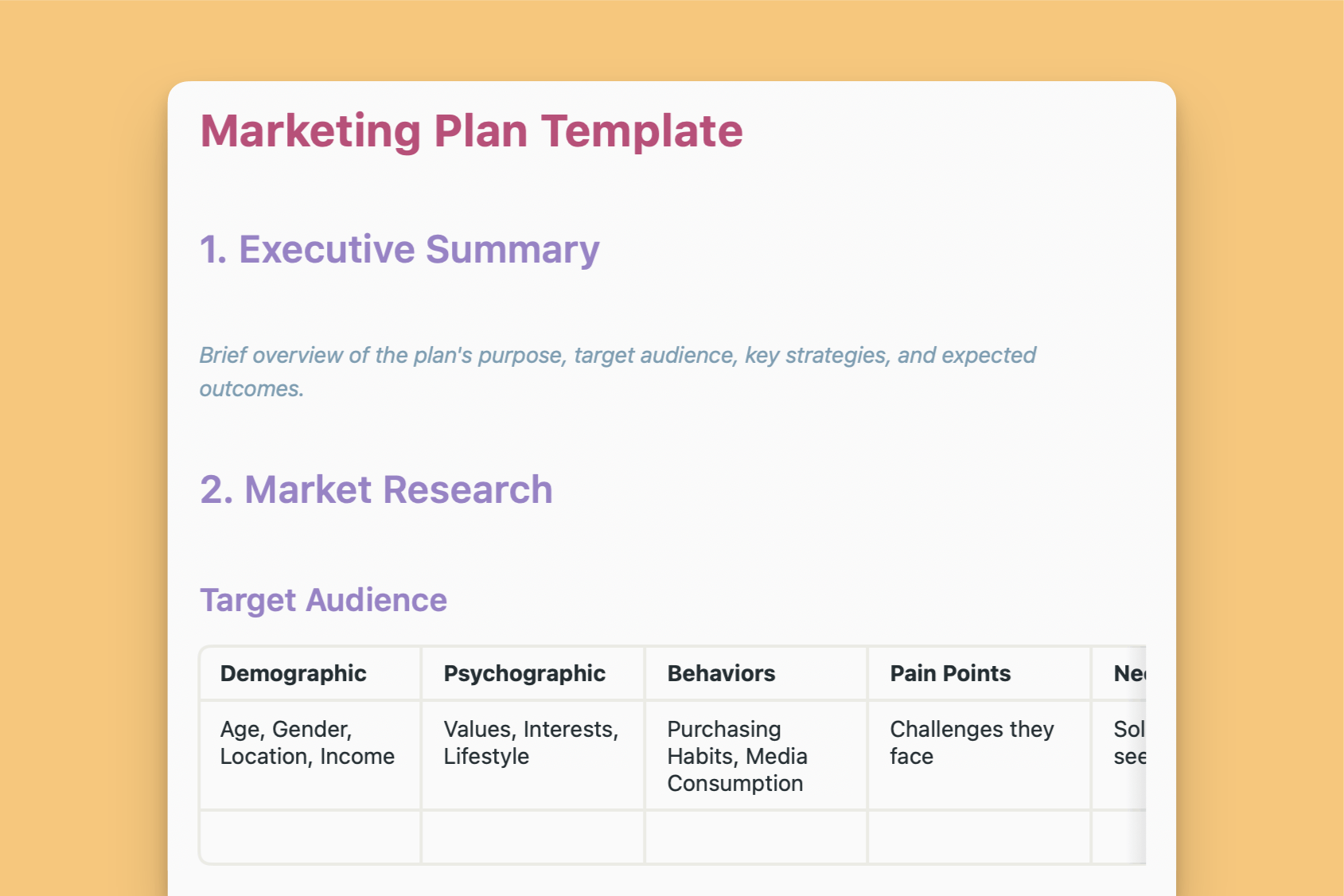Home

Marketing Plan Template
This template guides you through creating a marketing plan, including market research, strategy, budget, and timeline.
Get things done with NotePlan
Categories
This NotePlan template is a meticulously structured framework designed to streamline the process of crafting a comprehensive and effective marketing plan. It guides you through every crucial aspect of marketing, ensuring that no detail is overlooked.
1. Executive Summary:
Begin by summarizing the plan's essence, outlining its core purpose, the targeted audience, the overarching strategies, and the desired outcomes. Think of this as your elevator pitch for the entire plan.
2. Market Research:
- Target Audience: Delve deep into your ideal customers. Use a table to segment them based on demographics (age, gender, location, etc.), psychographics (values, interests, lifestyle), behaviors (purchase patterns, media consumption), pain points, and needs.
- Competitive Analysis: Use a SWOT (Strengths, Weaknesses, Opportunities, Threats) analysis table to dissect your key competitors, understanding their advantages and vulnerabilities in the market.
- Market Trends: List the current trends shaping your industry and how they might affect your product or service.
3. Strategy Overview:
- Positioning: Craft a clear statement explaining how your product/service stands out in the market – what makes it unique and desirable.
- Value Proposition: Articulate the specific benefits your offering brings to customers.
- Key Messages: Distill your core messages into succinct, powerful statements that resonate with your target audience.
4. Goals & Objectives:
- SMART Goals: Set Specific, Measurable, Achievable, Relevant, and Time-Bound goals. Use a table to track each goal, the associated metric, the target value, and the timeframe.
- KPIs: Identify the Key Performance Indicators that will help you measure your progress toward achieving your goals. Use a table to list each KPI, the target value, and the current value.
5. Budget:
- Total Budget: Clearly state the overall amount allocated for the entire marketing campaign.
- Channel Breakdown: Use a table to break down how the budget is distributed across various marketing channels (e.g., digital advertising, content marketing, traditional marketing).
6. Timeline:
- Campaign Start/End Dates: Specify the overall timeline for your campaign.
- Key Milestones: Use a table to map out significant dates for launches, events, promotions, etc.
7. Marketing Channels:
- Digital Marketing: Use a table to detail your plans for SEO, PPC, social media, email marketing, and other digital channels. Include strategies, budgets, and KPIs for each.
- Content Marketing: Summarize your content strategy, outlining the types of content you'll create, the platforms you'll use, and how you'll measure success.
- Traditional Marketing: List any planned activities in traditional channels like PR, print advertising, or events.
8. Measurement & Evaluation:
Describe how you'll track your KPIs, the tools you'll use, the frequency of reporting, and your plan for analyzing data and optimizing the campaign over time.
9. Contingency Planning:
- Potential Risks: Identify potential challenges that could derail your plans (e.g., budget constraints, unexpected competitor actions).
- Mitigation Strategies: Use a table to outline how you'll address these risks if they arise.
10. Appendix:
Include any supplementary documents relevant to your plan, such as market research data, creative briefs, or media plans.
Why Use This Template:
- Structured Approach: Ensures a comprehensive, well-organized marketing plan.
- Visual Clarity: Tables enhance readability and make data comparison easy.
- Adaptability: Can be customized to fit any industry or campaign.
- Collaboration: Easy to share and discuss with team members.
This NotePlan template serves as your roadmap to a successful marketing campaign. It's designed to be a living document that you update and refine as your campaign progresses. Use it to guide your decision-making, measure your success, and ultimately achieve your marketing goals.